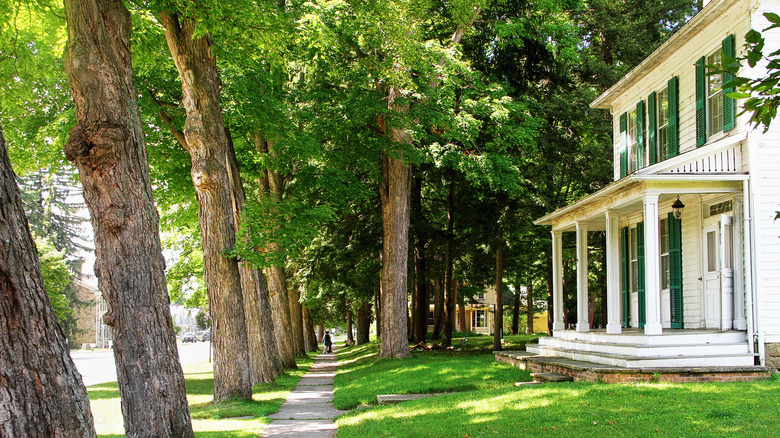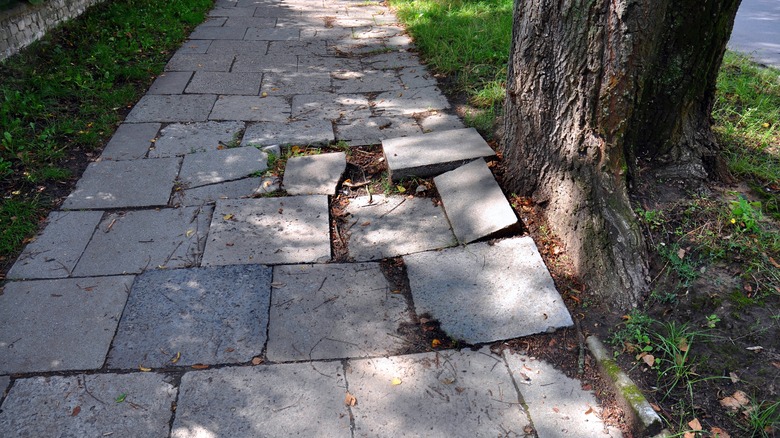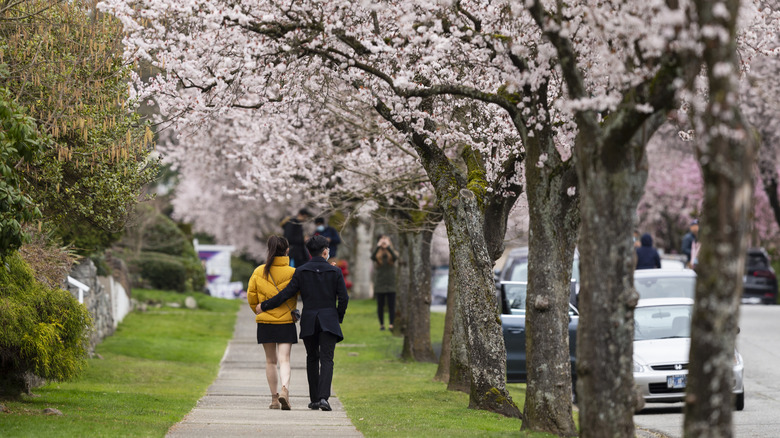Why You Should Think Twice Before Planting A Tree Close To Your Sidewalk
It may seem like a movie scene to walk along a sidewalk on a tree-lined street with the canopies on either side nearly touching. Yet, from a practical point of view, there are some risks to planting trees too close to the sidewalk, and it has nothing to do with leaf cleanup. Instead, it has to do with the roots of those trees and how they may navigate towards and under the cement sidewalk, potentially creating a risk of damage to it.
You can plant trees near your sidewalk, but you should choose trees that are less likely to do this. Some trees have root systems that are powerful and capable of breaking through just about anything as they seek out nutrients and water. That creates some significant downsides to planting a tree close to your sidewalk. The goal of any sidewalk is to remain flat to make walking easy to do and less likely to lead to tripping hazards.
Before planting a tree, think about the space carefully. Think about what it may look like in 5 to 10 years as the tree matures. Look up to notice any wires from electrical lines and look down to make sure there are no risks to water lines. Then, consider solid structures nearby that could suffer, like retaining walls, driveways, patios, and, of course, sidewalks. By following a few tips, you can minimize having to make costly sidewalk repairs due to roots growing and breaking through these surfaces.
Where to plant trees near the sidewalk
The problem with planting trees near the sidewalk is their root system. Depending on the type of tree, the roots may spread outward from the root ball, not just downward. These trees have fibrous, lateral root systems. As they travel horizontally across the soil to find water sources, the roots will grow in size. As that happens, they can disrupt the sidewalk above. Even if you have a thick layer of cement in place, like near your driveway, the roots can expand so much in some trees that they can cause the dirt to become unstable, leading to the risk of cracks.
Considering this, keep trees away from the sidewalk when possible, especially any with lateral root systems. It's ideal to keep them at least three to five feet from the sidewalk if they are trees that will grow to reach 30 feet in height. Trees that get larger than this need twice as much space away from the sidewalk or more. If your tree is likely to reach 50 feet or more, it's beneficial to keep it at least eight to 10 feet from the sidewalk. The roots can expand and grow that far, and with larger trees, the roots tend to be much wider as well, increasing the risk of damage. The good news is that these trees, even that far away, can create a beautiful canopy because of how tall and wide their branches are likely to be.
Best trees to plant close to a sidewalk
When you want to plant trees closer to the sidewalk, adjust the type of tree you're planting to one that forms a deep taproot, rather than lateral roots. These trees have a root ball that will push roots lower, penetrating deeper into the ground in search of nutrients, instead of just growing them horizontally. The roots are less likely to be close to the soil surface, which means less risk for damage. While you still want some space, these trees tend to be a better option for planting closer to the sidewalk or other cement or paver structure.
Some of the ideal trees that have this type of tree root system include dogwood, cherry, and linden. You can also plant white oak, hornbeam, and hickory, but be careful with those that are likely to reach over 30 feet in height. They can still have significant root systems that could disrupt some surfaces. Keep in mind that various species of each of these trees may have slightly different root systems.
Also, note that where you plant a tree also has to be good for that plant. That means ensuring proper access to quality soil and enough room to grow. Choose trees based on their maintenance needs, considering how much pruning the tree needs, if it will drop a significant number of leaves or fruit near the sidewalk, and how resistant it is to weather conditions.


